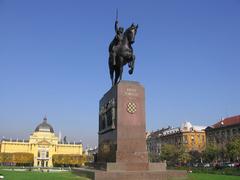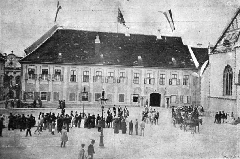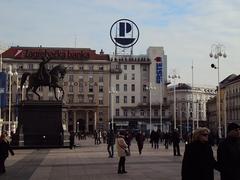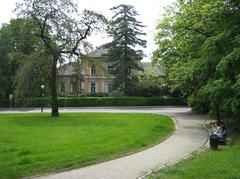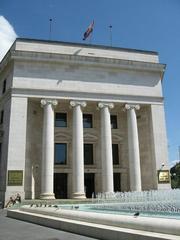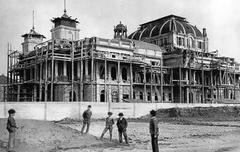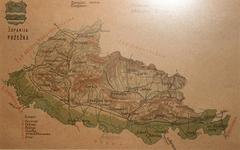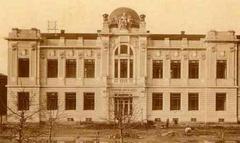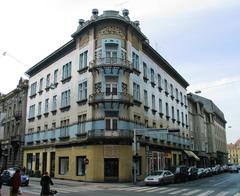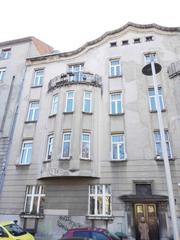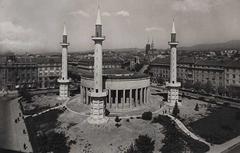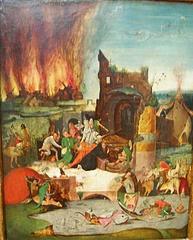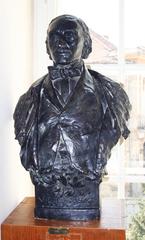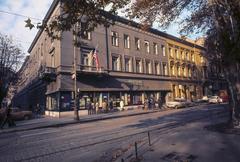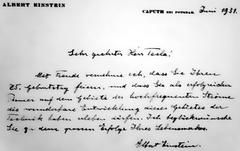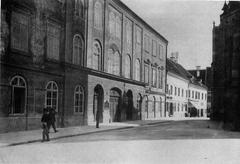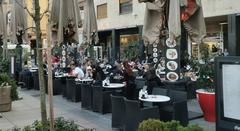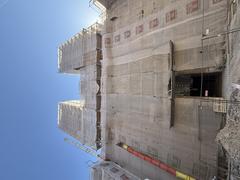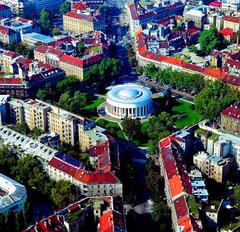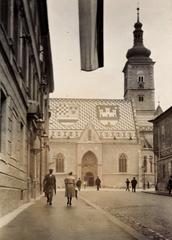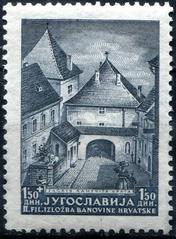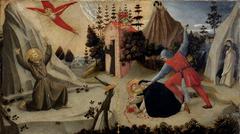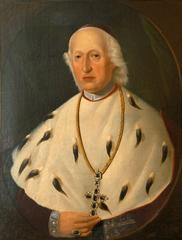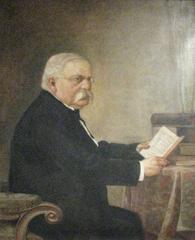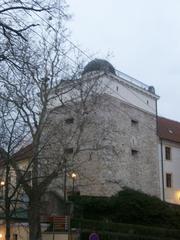Kula Lotrščak Visiting Hours, Tickets, and Tips - Zagreb Historical Sites Guide
Date: 18/07/2024
Introduction to Kula Lotrščak - A Historical Gem in Zagreb
Kula Lotršćak, also known as Lotrščak Tower, stands as one of Zagreb’s most iconic historical and cultural landmarks. Situated in the Upper Town (Gornji Grad), the tower, constructed around 1266, was an integral part of the southern defense system for the fortified settlement of Gradec. This settlement, now part of modern-day Zagreb, was granted significant autonomy and privileges by King Béla IV of Hungary following the Mongol invasion in 1242, including the right to build fortifications (Zagreb Tourist Board). The name ‘Lotršćak’ is derived from the Latin phrase ‘campana latrunculorum,’ meaning ‘the bell of thieves,’ referring to the tower’s original function of signaling the closing of the town gates every evening (Croatia.hr).
The tower has evolved architecturally and functionally over the centuries. Initially a simple defensive structure with thick stone walls and narrow windows, it was later modified to include a clock and a viewing platform in the 19th century, enhancing its role as a timekeeper and lookout point. One of its most notable features today is the Grič Cannon, which has been housed in the tower since 1877 and is fired daily at noon as a time signal for the city (Zagreb City Museum).
Visiting Kula Lotršćak offers more than just a glimpse into the past; it provides panoramic views of Zagreb and a deeper understanding of the city’s rich heritage. This guide will provide you with comprehensive information about the tower’s history, visiting hours, ticket prices, nearby attractions, and practical tips to ensure a memorable visit.
Table of Contents
- [History of Kula Lotršćak](#history-of-kula-lotršćakhistory-of-kula-lotršćak)
- [Introduction](#introductionintroduction)
- [Origins and Construction](#origins-and-constructionorigins-and-construction)
- [Etymology](#etymologyetymology)
- [Role in Defense](#role-in-defenserole-in-defense)
- [The Grič Cannon](#the-grič-cannonthe-grič-cannon)
- [Architectural Evolution](#architectural-evolutionarchitectural-evolution)
- [Cultural Significance](#cultural-significancecultural-significance)
- [Visitor Information](#visitor-informationvisitor-information)
- [Visiting Hours](#visiting-hoursvisiting-hours)
- [Tickets](#ticketstickets)
- [Guided Tours](#guided-toursguided-tours)
- [Travel Tips](#travel-tipstravel-tips)
- [Nearby Attractions](#nearby-attractionsnearby-attractions)
- [Best Photographic Spots](#best-photographic-spotsbest-photographic-spots)
- [Accessibility](#accessibilityaccessibility)
- [Preservation and Tourism](#preservation-and-tourismpreservation-and-tourism)
- [Modern-Day Relevance](#modern-day-relevancemodern-day-relevance)
- [FAQ](#faqfaq)
- [Call to Action](#call-to-actioncall-to-action)
History of Kula Lotršćak
Introduction
Kula Lotršćak, also known as Lotrščak Tower, is a significant historical and cultural landmark in Zagreb, Croatia. This article will delve into the rich history of the tower, provide practical information for visitors, and highlight its cultural significance.
Origins and Construction
Kula Lotršćak was constructed around 1266 as part of the southern defense system of the Gradec town walls. Gradec, now part of Zagreb’s Upper Town (Gornji Grad), was a fortified settlement granted a royal charter by King Béla IV of Hungary in 1242, following the Mongol invasion. This charter provided the town with significant autonomy and privileges, including the right to build fortifications (Zagreb Tourist Board).
Etymology
The name “Lotršćak” is derived from the Latin phrase “campana latrunculorum,” meaning “the bell of thieves.” This name is linked to the tower’s original function of housing a bell that signaled the closing of the town gates each evening, warning townspeople to return within the safety of the walls (Croatia.hr).
Role in Defense
Kula Lotršćak played a crucial role in the defense of Gradec. Strategically positioned to oversee the southern approach to the town, the tower’s thick stone walls and narrow windows were designed to withstand sieges and assaults. Over the centuries, the tower was modified to adapt to changing military technologies and threats (Zagreb City Museum).
The Grič Cannon
One of the most notable features of Kula Lotršćak is the Grič Cannon, housed in the tower since 1877. The cannon is fired daily at noon to provide a time signal for the city’s residents and to synchronize the clocks of the city’s churches and public buildings. This tradition has become a beloved local custom and a popular attraction for visitors (Zagreb Tourist Board).
Architectural Evolution
Over the centuries, Kula Lotršćak has undergone several architectural changes. Originally a simple defensive structure, it was renovated in the 19th century to include a clock and a viewing platform, enhancing its role as a timekeeper and lookout point. The addition of the Grič Cannon further cemented its status as a symbol of the city (Zagreb City Museum).
Cultural Significance
Kula Lotršćak is not only a historical monument but also a cultural icon of Zagreb. The tower is featured prominently in local folklore and literature, symbolizing the city’s resilience and historical continuity. It is part of the Upper Town’s architectural ensemble, which includes other landmarks such as St. Mark’s Church and the Stone Gate. The daily firing of the Grič Cannon serves as a reminder of Zagreb’s rich heritage (Croatia.hr).
Visitor Information
Visiting Hours
Kula Lotršćak is open daily from 9 AM to 8 PM. It is advisable to check the official website for any changes in the schedule or special closures.
Tickets
Admission fees are approximately 20 HRK for adults and 10 HRK for children. Tickets can be purchased at the entrance or online.
Guided Tours
Guided tours are available and provide in-depth historical insights. These tours are offered in multiple languages and can significantly enhance your understanding of the site’s history.
Travel Tips
Nearby Attractions
After visiting Kula Lotršćak, explore nearby attractions such as St. Mark’s Church, the Stone Gate, and the Museum of Broken Relationships.
Best Photographic Spots
The viewing platform at the top of the tower offers panoramic views of Zagreb, making it an ideal spot for photography. Visit during the golden hour for the best light.
Accessibility
The tower has limited accessibility for visitors with mobility issues due to its historical structure and the narrow, steep staircase leading to the top. However, efforts are made to accommodate all guests where possible.
Preservation and Tourism
Kula Lotršćak is meticulously preserved and managed by the Zagreb City Museum. Visitors can explore the tower’s interior, which includes exhibits on its history and the Grič Cannon. The viewing platform offers stunning views of Zagreb, making it a popular destination for tourists (Zagreb City Museum).
Modern-Day Relevance
Today, Kula Lotršćak stands as a testament to Zagreb’s medieval past and its evolution into a modern city. The tower’s historical significance and its role in the daily life of the city make it a cherished landmark. The tradition of the Grič Cannon continues to draw visitors, while the tower itself serves as a symbol of the city’s enduring spirit (Zagreb Tourist Board).
FAQ
- What are the visiting hours for Kula Lotršćak?
- Kula Lotršćak is open daily from 9 AM to 8 PM.
- How much do tickets to Kula Lotršćak cost?
- Admission fees are approximately 20 HRK for adults and 10 HRK for children.
- Are there guided tours available at Kula Lotršćak?
- Yes, guided tours are available and provide in-depth historical insights.
Call to Action
Plan your visit to Kula Lotršćak and explore one of Zagreb’s most iconic landmarks. Download the Audiala mobile app for more travel tips and updates. Follow us on social media for the latest news on Zagreb’s historical sites.
Conclusion - Summary of Key Points
Kula Lotršćak is more than just a historical monument; it is a symbol of Zagreb’s resilience and continuity through the ages. From its origins as a defensive tower to its modern-day role as a cultural icon, Kula Lotršćak encapsulates the city’s rich history and evolving identity. The daily firing of the Grič Cannon and the panoramic views from the tower’s viewing platform make it a must-visit destination for both locals and tourists. The tower’s preservation and the continued tradition of the cannon firing underscore its significance in the daily life of the city (Zagreb Tourist Board).
Whether you’re a history enthusiast, a photography aficionado, or simply someone looking to explore Zagreb’s cultural landmarks, a visit to Kula Lotršćak will provide a fulfilling and enriching experience. Make sure to explore nearby attractions such as St. Mark’s Church and the Museum of Broken Relationships to fully immerse yourself in the charm and history of Zagreb’s Upper Town (Croatia.hr).
Plan your visit to Kula Lotršćak and experience firsthand the captivating blend of history, culture, and breathtaking views that this iconic tower has to offer. For more travel tips, updates, and to enhance your visit, consider downloading the Audiala mobile app.
References
- Zagreb Tourist Board. https://www.infozagreb.hr
- Croatia.hr. https://croatia.hr
- Zagreb City Museum. https://www.mgz.hr

